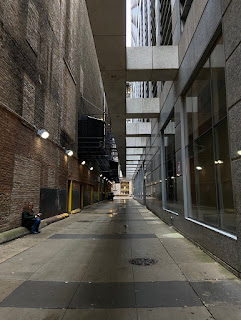Grids in society
“Grids function throughout society.” (Lupton 187)
Grids are utilized everywhere in daily life. They provide structure and function. This week, I took a trip into the city to see if I could find grids without actively seeking them out/ being too obvious.
This alley way utilizes grids everywhere. From the windows on the right, to the street to the wall on the left. There are clear and distinct squares practically everywhere you look. Moreover, it utilizes the theme of pattern as well because they are all ongoing repetitive and succinct.
In this image, it may be a little more difficult to see the grid. "the grid can work quietly in the background, or it can assert itself as an active element" (Lupton & Phillips 175). this quote, I feel, can directly apply to this image. The sushi itself, is a grid, each piece representing a square. The placement of the napkin underneath the food acts as a grid in the background as well. The tray itself has a pattern on it and it too works as a grid underneath it all.
This image the windows of the building act as the grid.
My favorite photo. Here the grid once again is more subtle and in the background, is the backsplash behind the cat.
All photos by me on Instagram




These photos are so aesthetically pleasing. I love it!
ReplyDeleteI love love LOVE your first image! It really encapsulates this weeks material in grids. Wowww!!!
ReplyDeleteI really enjoy all the different and dynamic photos you always take, you have such an eye for it. Great way to represent this week's theme in such different aspects of society.
ReplyDeleteI respect how much personality shines in your pictures! So beautiful!
ReplyDeleteI love city structures! I’m getting Chicago vibes.
ReplyDeleteTheses photos are very pleasing to see.
ReplyDelete